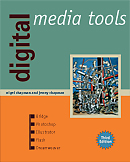
See the book at amazon.co.uk or amazon.com
Related Books

See Digital Multimedia at amazon.co.uk or amazon.com

See Web Design: A Complete Introduction at amazon.co.uk or amazon.com
The authors are not responsible for the content of any external sites linked to from digitalmediatools.org
All material on this site is ©2007–2010 MacAvon Media and may not be reproduced without permission.
Bridge Teaching Notes
If your students are not going to be working with large numbers of files, you could safely omit this short chapter. However, since there isn't much to Bridge, it is worth encouraging students to take a look at it, even though it is hard to motivate its use unless you have a lot of material to organize.
On the other hand, if students are working with digital photographs, or creating non-trivial Web sites, one of their problems will be managing the images and other media elements, since collections of photographs or video clips can rapidly become too large to manage easily. In that case, a quick introduction to Bridge when they have enough material to make it worthwhile could make their lives easier. Tagging is something that most students will be familiar with at the moment, so this can provide a route into ideas about keywords and metadata generally. Building collections of material relevant to a particular project is easy and can be extremely useful.
Other options for organizing media exist, of course. If you are working on Mac systems, there is iPhoto, which students may already be familiar with. However, it is not integrated with the other CS3 programs in the way that Bridge is, and only handles bitmapped images. The way it imports files into its own library instead of letting you manage their locations yourself is more suited to consumers than to professionals.
For digital photographers, Lightroom, which incorporates many professional image processing functions as well as image management, is a better choice, especially given its relatively low cost, but it is specifically intended for photography and is not as useful for multimedia work as Bridge. (And Bridge comes with the CS3 suites.)